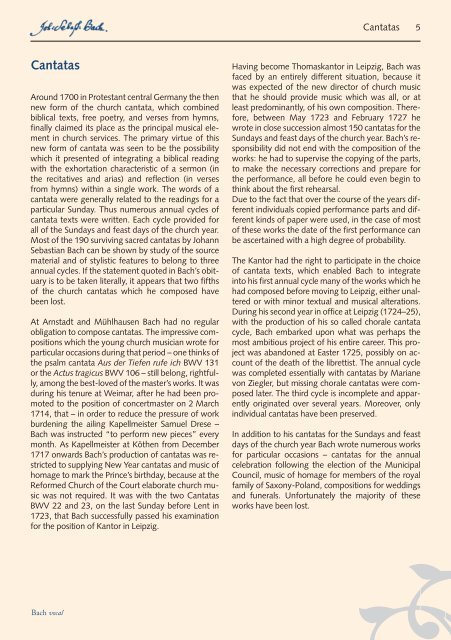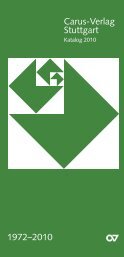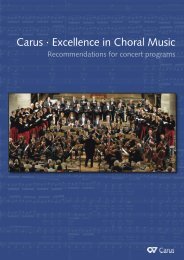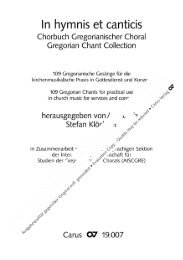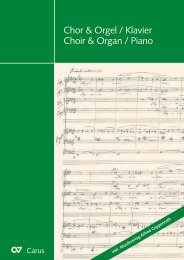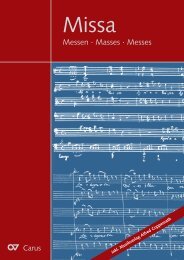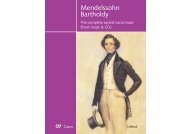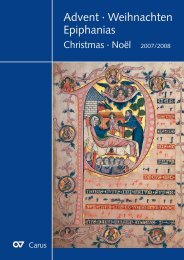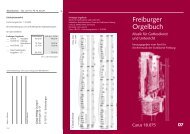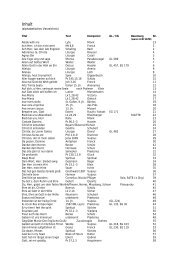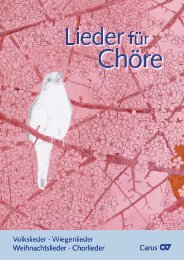Cantatas · Masses · Oratorios Passions · Motets
Cantatas · Masses · Oratorios Passions · Motets
Cantatas · Masses · Oratorios Passions · Motets
You also want an ePaper? Increase the reach of your titles
YUMPU automatically turns print PDFs into web optimized ePapers that Google loves.
<strong>Cantatas</strong><br />
Around 1700 in Protestant central Germany the then<br />
new form of the church cantata, which combined<br />
biblical texts, free poetry, and verses from hymns,<br />
finally claimed its place as the principal musical element<br />
in church services. The primary virtue of this<br />
new form of cantata was seen to be the possibility<br />
which it presented of integrating a biblical reading<br />
with the exhortation characteristic of a sermon (in<br />
the recitatives and arias) and reflection (in verses<br />
from hymns) within a single work. The words of a<br />
cantata were generally related to the readings for a<br />
particular Sunday. Thus numerous annual cycles of<br />
cantata texts were written. Each cycle provided for<br />
all of the Sundays and feast days of the church year.<br />
Most of the 190 surviving sacred cantatas by Johann<br />
Sebastian Bach can be shown by study of the source<br />
material and of stylistic features to belong to three<br />
annual cycles. If the statement quoted in Bach’s obituary<br />
is to be taken literally, it appears that two fifths<br />
of the church cantatas which he composed have<br />
been lost.<br />
At Arnstadt and Mühlhausen Bach had no regular<br />
obligation to compose cantatas. The impressive compositions<br />
which the young church musician wrote for<br />
particular occasions during that period – one thinks of<br />
the psalm cantata Aus der Tiefen rufe ich BWV 131<br />
or the Actus tragicus BWV 106 – still belong, rightfully,<br />
among the best-loved of the master’s works. It was<br />
during his tenure at Weimar, after he had been promoted<br />
to the position of concertmaster on 2 March<br />
1714, that – in order to reduce the pressure of work<br />
burdening the ailing Kapellmeister Samuel Drese –<br />
Bach was instructed “to perform new pieces” every<br />
month. As Kapellmeister at Köthen from December<br />
1717 onwards Bach’s production of cantatas was restricted<br />
to supplying New Year cantatas and music of<br />
homage to mark the Prince’s birthday, because at the<br />
Reformed Church of the Court elaborate church music<br />
was not required. It was with the two <strong>Cantatas</strong><br />
BWV 22 and 23, on the last Sunday before Lent in<br />
1723, that Bach successfully passed his examination<br />
for the position of Kantor in Leipzig.<br />
Bach vocal<br />
<strong>Cantatas</strong> 5<br />
Having become Thomaskantor in Leipzig, Bach was<br />
faced by an entirely different situation, because it<br />
was expected of the new director of church music<br />
that he should provide music which was all, or at<br />
least predominantly, of his own composition. Therefore,<br />
between May 1723 and February 1727 he<br />
wrote in close succession almost 150 cantatas for the<br />
Sundays and feast days of the church year. Bach’s responsibility<br />
did not end with the composition of the<br />
works: he had to supervise the copying of the parts,<br />
to make the necessary corrections and prepare for<br />
the performance, all before he could even begin to<br />
think about the first rehearsal.<br />
Due to the fact that over the course of the years different<br />
individuals copied performance parts and different<br />
kinds of paper were used, in the case of most<br />
of these works the date of the first performance can<br />
be ascertained with a high degree of probability.<br />
The Kantor had the right to participate in the choice<br />
of cantata texts, which enabled Bach to integrate<br />
into his first annual cycle many of the works which he<br />
had composed before moving to Leipzig, either unaltered<br />
or with minor textual and musical alterations.<br />
During his second year in office at Leipzig (1724–25),<br />
with the production of his so called chorale cantata<br />
cycle, Bach embarked upon what was perhaps the<br />
most ambitious project of his entire career. This project<br />
was abandoned at Easter 1725, possibly on account<br />
of the death of the librettist. The annual cycle<br />
was completed essentially with cantatas by Mariane<br />
von Ziegler, but missing chorale cantatas were composed<br />
later. The third cycle is incomplete and appar -<br />
ently originated over several years. Moreover, only<br />
individual cantatas have been preserved.<br />
In addition to his cantatas for the Sundays and feast<br />
days of the church year Bach wrote numerous works<br />
for particular occasions – cantatas for the annual<br />
celebration following the election of the Municipal<br />
Council, music of homage for members of the royal<br />
family of Saxony-Poland, compositions for weddings<br />
and funerals. Unfortunately the majority of these<br />
works have been lost.


